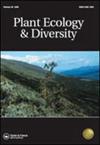氮添加导致苜蓿切换氮源
IF 1.6
4区 生物学
Q2 PLANT SCIENCES
引用次数: 1
摘要
背景氮(N)添加可能对豆科植物的生长及其生物固氮(BNF)产生强烈影响,但豆科植物氮获取源对N输入的响应尚未得到全面评估。目的定量研究施氮量对紫花苜蓿生长和生物量的影响,探讨豆科植物氮素获取对施氮量的响应。方法在不同NH4NO3添加梯度的温室条件下栽培芥花,分析与生长和BNF相关的N浓度、生物量、δ15N值、根瘤数、大气氮来源百分比(Ndfa%)等变量。结果氮素添加对植物生物量和叶面氮浓度影响不大。叶片δ15N值随施氮量的增加而增加,Ndfa%则降低。结瘤数随氮的增加而减少,而单位根瘤质量的氮酶(nifH)基因数随氮的增加无显著差异。结论矿质氮有效性的增加减少了共生植物对BNF的投资,主要是通过减少结核的形成;研究发现,这对植物生长没有显著影响,因为植物将其氮源从BNF-N转变为来自土壤的矿质氮。本文章由计算机程序翻译,如有差异,请以英文原文为准。
Nitrogen addition results in Medicago sativa switching nitrogen sources
ABSTRACT Background Nitrogen (N) addition may have strong impacts on legume growth and their biological N fixation (BNF), but how legume N acquisition sources respond to N inputs have yet to be comprehensively assessed. Aims We quantified the effects of N addition on the growth and BNF of Medicago sativa and to assess the response of legume N acquisition to N addition. Methods We grew M. sativa in the greenhouse under gradients of added NH4NO3 and analysed the variables that were relative to growth and BNF, such as N concentration, biomass, δ15N values, nodule number, percentage of N derived from the atmosphere (Ndfa%). Results Nitrogen addition had marginal effects on plant biomass production and foliar N concentration. Foliar δ15N value increased with increasing added N, while Ndfa% decreased. The number of nodules formed also decreased with N addition while the nitrogenase (nifH)genecopies per unit nodule mass was not significantly different with N addition. Conclusions These findings indicate that increasing mineral N availability decreases symbiotic investment into BNF, mainly by reducing nodule formation; this was found to have no significant impact on plant growth because the plant changes its N source from BNF-N to mineral N derived from the soil.
求助全文
通过发布文献求助,成功后即可免费获取论文全文。
去求助
来源期刊

Plant Ecology & Diversity
PLANT SCIENCES-
CiteScore
3.30
自引率
0.00%
发文量
26
审稿时长
3 months
期刊介绍:
Plant Ecology and Diversity is an international journal for communicating results and novel ideas in plant science, in print and on-line, six times a year. All areas of plant biology relating to ecology, evolution and diversity are of interest, including those which explicitly deal with today''s highly topical themes, such as biodiversity, conservation and global change. We consider submissions that address fundamental questions which are pertinent to contemporary plant science. Articles concerning extreme environments world-wide are particularly welcome.
Plant Ecology and Diversity considers for publication original research articles, short communications, reviews, and scientific correspondence that explore thought-provoking ideas.
To aid redressing ‘publication bias’ the journal is unique in reporting, in the form of short communications, ‘negative results’ and ‘repeat experiments’ that test ecological theories experimentally, in theoretically flawless and methodologically sound papers. Research reviews and method papers, are also encouraged.
Plant Ecology & Diversity publishes high-quality and topical research that demonstrates solid scholarship. As such, the journal does not publish purely descriptive papers. Submissions are required to focus on research topics that are broad in their scope and thus provide new insights and contribute to theory. The original research should address clear hypotheses that test theory or questions and offer new insights on topics of interest to an international readership.
 求助内容:
求助内容: 应助结果提醒方式:
应助结果提醒方式:


